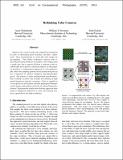Rethinking color cameras
Author(s)
Chakrabarti, Ayan; Freeman, William T.; Zickler, Todd
DownloadrethinkingColorCameras.pdf (4.894Mb)
OPEN_ACCESS_POLICY
Open Access Policy
Creative Commons Attribution-Noncommercial-Share Alike
Terms of use
Metadata
Show full item recordAbstract
Digital color cameras make sub-sampled measurements of color at alternating pixel locations, and then “demosaick” these measurements to create full color images by up-sampling. This allows traditional cameras with restricted processing hardware to produce color images from a single shot, but it requires blocking a majority of the incident light and is prone to aliasing artifacts. In this paper, we introduce a computational approach to color photography, where the sampling pattern and reconstruction process are co-designed to enhance sharpness and photographic speed. The pattern is made predominantly panchromatic, thus avoiding excessive loss of light and aliasing of high spatial-frequency intensity variations. Color is sampled at a very sparse set of locations and then propagated throughout the image with guidance from the un-aliased luminance channel. Experimental results show that this approach often leads to significant reductions in noise and aliasing artifacts, especially in low-light conditions.
Date issued
2014-05Department
Massachusetts Institute of Technology. Department of Electrical Engineering and Computer ScienceJournal
Proceedings of the 2014 IEEE International Conference on Computational Photography (ICCP)
Publisher
Institute of Electrical and Electronics Engineers (IEEE)
Citation
Chakrabarti, Ayan, William T. Freeman, and Todd Zickler. “Rethinking Color Cameras.” 2014 IEEE International Conference on Computational Photography (ICCP) (May 2014).
Version: Author's final manuscript
ISBN
978-1-4799-5188-8